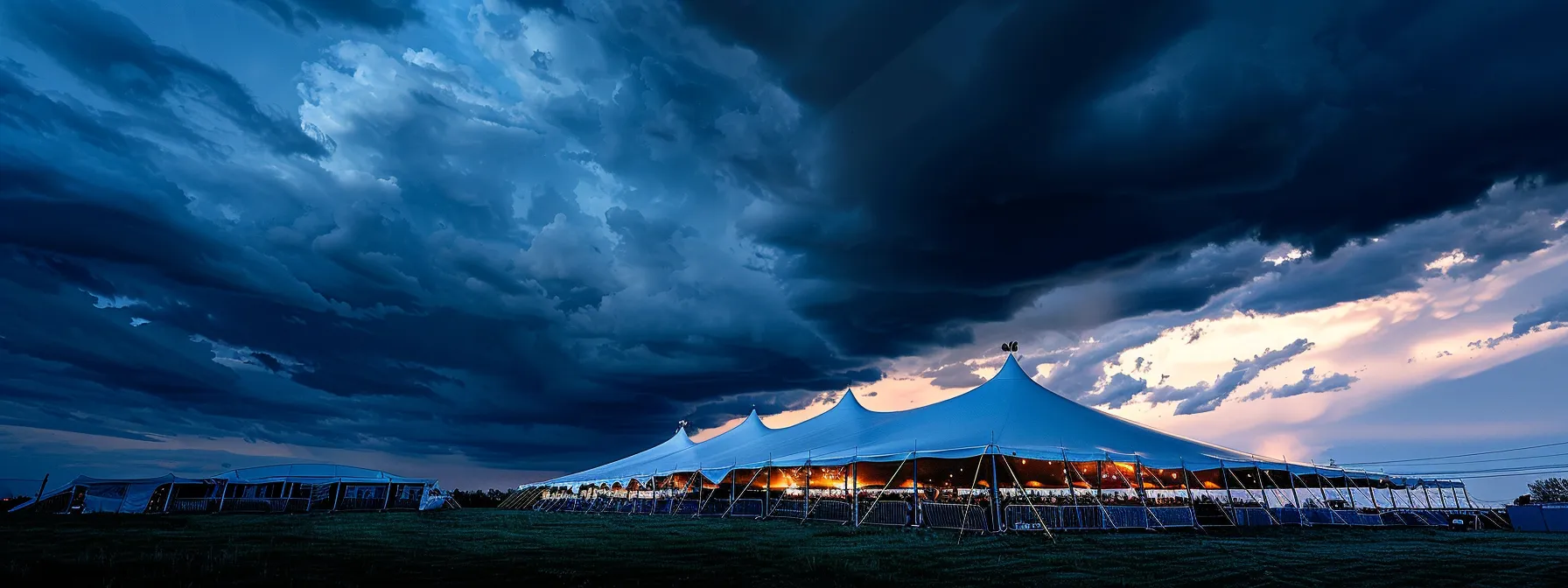Are you planning a large event and concerned about tent safety? Proper tent installation is crucial to protect guests from potential hazards like wind, lightning, and other risks. This guide covers essential safety tips for tent setup, including site preparation, equipment use, and weather monitoring. By following these guidelines, you’ll ensure a secure environment for your gathering and gain peace of mind during your event.
Key Takeaways
- Proper site preparation and assessment are crucial for safe tent installation at large gatherings
- Regular weather monitoring and contingency planning are essential for maintaining tent safety during events
- Effective communication of safety protocols to staff and guests is vital for a secure event
- Establishing a routine for inspections and maintenance helps prevent safety hazards throughout the event
- Documenting all safety checks and reports ensures accountability and aids in future event planning
Prepare the Site for Safe Tent Installation

Proper site preparation is crucial for safe tent installation at large gatherings. This process involves assessing ground conditions, identifying potential hazards, ensuring adequate space, and checking for underground utilities. These steps help prevent issues during construction and protect against extreme weather, ensuring a quality setup that can withstand rain and wind.
Assess Ground Conditions and Stability
Event planners must thoroughly assess ground conditions before installing event tents. Stable soil and level terrain are essential for secure anchoring and structural integrity. A comprehensive site evaluation helps identify potential hazards like soft spots, hidden rocks, or drainage issues that could compromise tent stability during a thunderstorm. Event tent safety also depends on proper weight distribution and tension, which rely on accurate ground assessment:
- Check soil composition and compaction
- Measure ground slope and identify uneven areas
- Locate underground utilities and obstacles
- Assess drainage patterns to prevent water accumulation
- Determine appropriate anchoring methods based on soil type
Identify Potential Hazards in the Area
Before tent installation, event organizers must identify potential hazards in the surrounding area. This includes checking for overhead obstacles like tree branches or power lines that could interfere with the tent’s roof. They should also account for nearby structures, landscaping features, and maintenance equipment that might impact tent placement or pose safety risks. Thorough site evaluation helps ensure a secure setup and allows organizers to skip potential content hazards during the installation process.
Ensure Sufficient Space Around the Tent
Ensuring sufficient space around the tent is crucial for safety during outdoor events, especially in severe weather. Event organizers should leave adequate clearance on all sides of the steel structure to allow for proper anchoring and emergency access. This safety measure also provides room for attendees to move freely and reduces the risk of accidents. Tips for proper spacing include:
| Aspect | Recommendation |
|---|---|
| Minimum clearance | 10 feet on all sides |
| Emergency vehicle access | 20-foot wide path |
| Guy wire placement | 5 feet beyond tent edge |
| Distance from structures | At least 20 feet |
Check for Underground Utilities
Checking for underground utilities is a critical step in risk management for safe tent installation. Event organizers must contact local utility companies to mark the locations of buried lines, including electrical, gas, water, and telecommunications. This precaution helps prevent accidental damage to underground infrastructure during stake driving or concrete anchor placement. Proper lighting installation and emergency evacuation planning also depend on accurate utility mapping. Here’s a summary of key considerations:
| Utility Type | Safety Measure |
|---|---|
| Electrical | Use non-conductive stakes near lines |
| Gas | Maintain safe distance for anchoring |
| Water | Avoid puncturing pipes during setup |
| Telecom | Protect fiber optic cables from damage |
Use Proper Equipment for Tent Setup
Proper equipment is crucial for safe tent installation at large gatherings. This section covers selecting appropriate tools, verifying equipment conditions, following manufacturer guidelines, and implementing worker safety gear. These steps ensure efficient setup, from handling flame retardant materials to preparing for heat, snow, and air conditioning needs. Using the right equipment minimizes risks and enhances overall event safety.
Select Appropriate Tools and Gear
Appropriate tools and gear are essential for safe tent installation at large gatherings. Event organizers should use specialized equipment designed for tent setup, including sturdy carts for transporting heavy poles and flame-retardant fabrics. They must also have emergency tools, such as fire extinguishers and first aid kits, to quickly address potential safety issues. Proper gear selection helps prevent damage to the tent and ensures efficient installation:
| Equipment Type | Purpose |
|---|---|
| Stake driver | Secure anchoring |
| Tension meter | Ensure proper fabric tightness |
| Safety harnesses | Fall protection for workers |
| Weather monitoring equipment | Track conditions for safety |
Verify Equipment Condition and Functionality
Event organizers must verify the condition and functionality of all equipment before tent installation. They should inspect poles, fabrics, and anchoring systems for signs of wear or damage. Testing tension devices, lighting systems, and safety equipment ensures proper operation during setup and throughout the event. Regular maintenance and prompt replacement of faulty components help prevent accidents and ensure a secure structure for large gatherings.
Follow Manufacturer Guidelines for Setup
Following manufacturer guidelines is crucial for safe tent installation at large gatherings. Event organizers must carefully read and adhere to the specific instructions provided for each tent model, ensuring proper assembly techniques and safety protocols are followed. This includes using the correct number of stakes, properly tensioning guy wires, and installing any required safety features. Strict adherence to manufacturer guidelines helps prevent structural failures and ensures the tent can withstand expected weather conditions throughout the event.
Implement Safety Gear for Workers
Event organizers must provide and enforce the use of appropriate safety gear for workers during tent installation. This includes hard hats, safety glasses, gloves, and steel-toed boots to protect against common hazards. Fall protection equipment such as harnesses and lanyards is essential for elevated work. Proper safety gear reduces the risk of injuries and ensures compliance with occupational safety regulations:
| Safety Gear | Purpose |
|---|---|
| Hard hats | Protect against falling objects |
| Safety glasses | Shield eyes from debris |
| Work gloves | Prevent cuts and abrasions |
| Steel-toed boots | Guard against foot injuries |
Ensure Structural Integrity During Installation

Ensuring structural integrity during tent installation is crucial for large gatherings. This section covers correct anchoring techniques, frame inspection, support stability, and adherence to building codes. These steps help create a safe and secure tent structure that can withstand various weather conditions and accommodate event attendees safely.
Utilize Correct Anchoring Techniques
Correct anchoring techniques are essential for tent stability and safety at large gatherings. Event organizers must use appropriate stakes, guy wires, and ballasts based on soil conditions and tent size. They should drive stakes at the correct angle and depth, ensuring proper tension on guy wires to distribute forces evenly. For hard surfaces, concrete blocks or water barrels serve as effective anchors. Proper anchoring helps tents withstand wind loads and prevents collapse during adverse weather conditions:
- Select stakes suitable for soil type and tent size
- Drive stakes at a 45-degree angle away from the tent
- Use guy wires to distribute tension evenly
- Employ ballasts for hard surface installations
- Regularly check and adjust anchoring during the event
Inspect Tent Frame for Weak Points
Before and during installation, event organizers must thoroughly inspect the tent frame for weak points. They should check for bent or damaged poles, loose connections, and signs of wear on structural components. This inspection helps identify potential failure points that could compromise the tent’s stability during severe weather or under heavy loads. Regular checks throughout the event ensure ongoing structural integrity:
- Examine poles for bends, cracks, or corrosion
- Check connectors and joints for tightness and alignment
- Inspect fabric attachment points for signs of stress or tearing
- Verify proper tensioning of support cables and guy wires
- Look for any unusual wear patterns or deformations in the frame
Confirm Support Stability Throughout
Confirming support stability throughout the tent installation process is crucial for ensuring the safety of large gatherings. Event organizers must regularly check and adjust support poles, guy wires, and anchoring systems during setup and throughout the event. They should pay close attention to load distribution, ensuring that weight is evenly spread across the structure to prevent sagging or collapse. Periodic inspections help identify and address any shifts in stability due to ground settling, wind pressure, or changes in occupancy load.
Adhere to Local Building Codes and Regulations
Event organizers must adhere to local building codes and regulations when installing tents for large gatherings. They should obtain necessary permits, follow fire safety guidelines, and ensure proper electrical and plumbing installations. Compliance with these regulations helps prevent structural failures, ensures occupant safety, and avoids potential legal issues. Regular inspections by local authorities may be required to maintain compliance throughout the event.
Monitor Weather Conditions Before and During Events

Monitoring weather conditions is crucial for tent safety at large gatherings. This section covers tracking wind speeds, preparing for sudden changes, developing contingency plans for severe weather, and ensuring proper ventilation. These measures help event organizers maintain a safe environment and respond quickly to potential weather-related hazards.
Keep Track of Wind Speeds and Forecasts
Event organizers must diligently track wind speeds and weather forecasts throughout tent installation and the duration of large gatherings. They should use reliable weather monitoring equipment and consult professional meteorological services to stay informed about current conditions and upcoming changes. Establishing clear wind speed thresholds for different actions, such as adjusting guy wires or evacuating the tent, is crucial for maintaining safety:
| Wind Speed (mph) | Action Required |
|---|---|
| 0-10 | Normal operations |
| 11-20 | Increase monitoring frequency |
| 21-30 | Adjust guy wires and secure loose items |
| 31-40 | Prepare for possible evacuation |
| 41+ | Evacuate tent immediately |
Prepare for Sudden Weather Changes
Event organizers must be ready for sudden weather changes during large gatherings in tents. They should establish a rapid response plan that includes steps for securing loose items, adjusting tent openings, and guiding attendees to safety if conditions deteriorate quickly. Keeping a weather radio on-site and designating a team member to monitor real-time updates helps ensure swift action when unexpected storms or strong winds approach.
Have a Contingency Plan for Severe Weather
Event organizers must develop a comprehensive contingency plan for severe weather during large gatherings in tents. This plan should outline specific actions to take when faced with various weather threats, such as thunderstorms, high winds, or heavy rain. Key elements of an effective severe weather contingency plan include:
- Designating safe shelter locations
- Establishing clear evacuation procedures
- Assigning roles and responsibilities to staff members
- Setting up a communication system for weather alerts
- Preparing emergency supplies and equipment
Ensure Proper Ventilation to Prevent Heat Issues
Proper ventilation is crucial for preventing heat-related issues during large gatherings in tents. Event organizers should strategically place fans, air conditioning units, or portable coolers to maintain comfortable temperatures and air circulation. They must also monitor humidity levels and adjust ventilation accordingly to prevent heat buildup, especially in crowded areas. Effective ventilation strategies include:
- Installing sidewall vents for cross-ventilation
- Using high-powered exhaust fans to remove hot air
- Positioning entrance and exit flaps to maximize airflow
- Implementing misting systems for outdoor cooling
- Regularly checking and maintaining HVAC equipment
Communicate Safety Protocols to Staff and Guests
Effective communication of safety protocols is crucial for tent installations at large gatherings. This section covers conducting safety briefings, displaying emergency procedures, training staff, and informing guests. These steps ensure all parties understand their roles in maintaining a safe environment throughout the event.
Conduct Safety Briefings Before Installation
Event organizers should conduct comprehensive safety briefings before tent installation begins. These sessions cover proper equipment use, hazard identification, and emergency procedures. Staff members learn their specific roles in maintaining a safe work environment and receive instruction on communicating potential risks effectively. Safety briefings help prevent accidents and ensure all workers understand their responsibilities during the installation process.
Display Emergency Exits and Procedures Clearly
Event organizers must clearly display emergency exits and procedures throughout the tent installation area. They should use large, visible signs to mark all exit points and provide clear, concise instructions for evacuation. Organizers should also create detailed maps showing the location of fire extinguishers, first aid stations, and assembly points. Regular announcements during the event can remind guests of these safety measures, ensuring everyone knows how to respond in case of an emergency.
Train Staff on Tent Safety Measures
Event organizers must provide comprehensive training to staff members on tent safety measures. This training should cover proper installation techniques, emergency response procedures, and ongoing safety monitoring throughout the event. Staff members should learn to identify potential hazards, perform regular safety checks, and respond quickly to changing weather conditions. By equipping staff with the necessary knowledge and skills, event organizers can significantly enhance the overall safety of tent installations for large gatherings.
Provide Guests With Important Safety Information
Event organizers must provide guests with essential safety information upon arrival at the tent installation. This includes pointing out emergency exits, explaining evacuation procedures, and highlighting the location of fire extinguishers and first aid stations. Organizers should also inform guests about weather-related safety protocols and encourage them to report any safety concerns to staff members immediately.
Schedule Regular Inspections and Maintenance

Regular inspections and maintenance are crucial for tent safety at large gatherings. This section covers establishing a maintenance routine, checking for wear and tear, planning safe dismantling procedures, and documenting safety checks. These practices help ensure the ongoing stability and safety of tent structures throughout events.
Establish a Tent Maintenance Routine
Event organizers must establish a comprehensive tent maintenance routine to ensure safety at large gatherings. This routine should include daily inspections of structural components, fabric tension, and anchoring systems. Staff members should be assigned specific tasks and inspection schedules, with clear protocols for reporting and addressing any issues discovered. Regular maintenance helps prevent small problems from escalating into serious safety hazards during the event.
Inspect for Wear and Tear After Use
After each use, event organizers must thoroughly inspect tents for signs of wear and tear. They should examine fabric panels for tears, check poles and connectors for damage, and assess guy wires and anchoring systems for integrity. This post-event inspection helps identify issues that may have developed during use and ensures timely repairs or replacements before the next installation. A systematic approach to wear and tear inspection includes:
| Component | Inspection Points |
|---|---|
| Fabric | Tears, holes, stains, mildew |
| Poles | Bends, cracks, corrosion |
| Connectors | Loose fittings, missing parts |
| Guy wires | Fraying, tension loss |
| Anchors | Bent stakes, loose grommets |
Plan for Safe Dismantling Procedures
Event organizers must plan safe dismantling procedures to ensure the proper takedown of tents after large gatherings. They should create a step-by-step process that outlines the correct order for removing components, starting with non-structural elements and progressing to the main support structures. This plan should include safety measures for workers, such as proper lifting techniques and the use of personal protective equipment. A well-organized dismantling process helps prevent accidents and damage to tent materials:
| Dismantling Step | Safety Consideration |
|---|---|
| Remove decorations and non-structural items | Clear work area of tripping hazards |
| Loosen and remove sidewalls | Use proper lifting techniques |
| Lower and remove roof panels | Ensure adequate personnel for heavy lifting |
| Disassemble frame components | Wear hard hats and safety gloves |
| Remove anchoring systems | Check for underground utility markers |
Document Safety Checks and Reports
Event organizers must document all safety checks and reports throughout the tent installation process and during the event. They should maintain detailed records of inspections, including dates, times, and findings, to ensure accountability and track potential issues over time. These documents serve as valuable references for future installations and can be crucial in addressing any safety concerns or incidents that may arise. A well-organized documentation system typically includes:
| Document Type | Contents |
|---|---|
| Pre-installation checklist | Site assessment, equipment verification |
| Daily inspection log | Structural integrity, weather conditions |
| Maintenance records | Repairs, replacements, adjustments |
| Incident reports | Safety issues, guest complaints, responses |
| Post-event evaluation | Overall performance, lessons learned |
Conclusion
Proper tent installation safety is crucial for large gatherings, encompassing site preparation, equipment selection, structural integrity, weather monitoring, and clear communication. Adhering to manufacturer guidelines, local regulations, and safety protocols helps prevent accidents and ensures a secure environment for attendees. Regular inspections, maintenance, and staff training are essential for identifying potential hazards and responding effectively to changing conditions. By prioritizing these safety measures, event organizers can create a enjoyable and secure experience for all participants while minimizing risks associated with outdoor tent installations.






